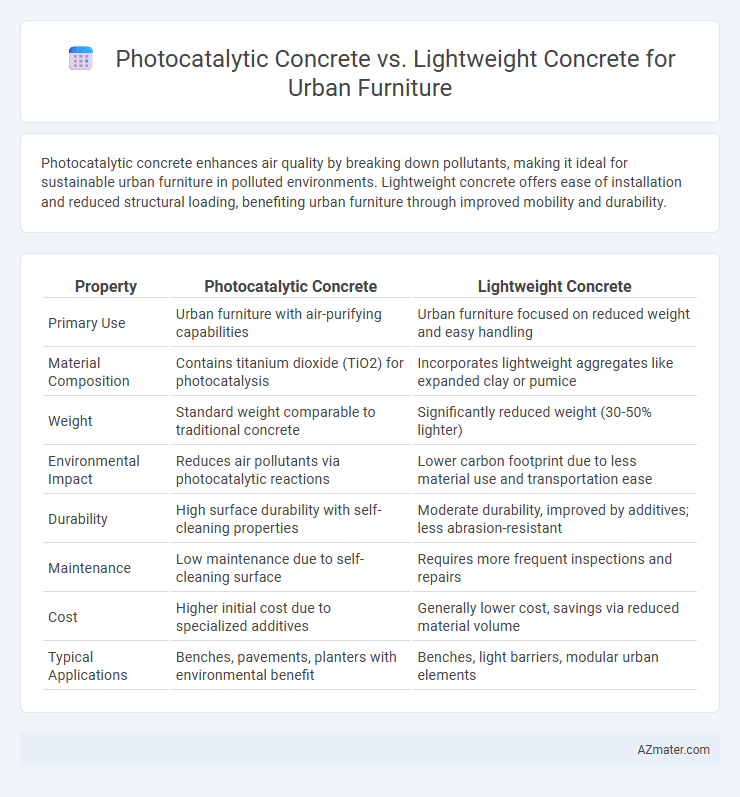Photocatalytic concrete enhances air quality by breaking down pollutants, making it ideal for sustainable urban furniture in polluted environments. Lightweight concrete offers ease of installation and reduced structural loading, benefiting urban furniture through improved mobility and durability.
Table of Comparison
| Property | Photocatalytic Concrete | Lightweight Concrete |
|---|---|---|
| Primary Use | Urban furniture with air-purifying capabilities | Urban furniture focused on reduced weight and easy handling |
| Material Composition | Contains titanium dioxide (TiO2) for photocatalysis | Incorporates lightweight aggregates like expanded clay or pumice |
| Weight | Standard weight comparable to traditional concrete | Significantly reduced weight (30-50% lighter) |
| Environmental Impact | Reduces air pollutants via photocatalytic reactions | Lower carbon footprint due to less material use and transportation ease |
| Durability | High surface durability with self-cleaning properties | Moderate durability, improved by additives; less abrasion-resistant |
| Maintenance | Low maintenance due to self-cleaning surface | Requires more frequent inspections and repairs |
| Cost | Higher initial cost due to specialized additives | Generally lower cost, savings via reduced material volume |
| Typical Applications | Benches, pavements, planters with environmental benefit | Benches, light barriers, modular urban elements |
Introduction to Urban Furniture Innovations
Photocatalytic concrete incorporates titanium dioxide to reduce air pollution by breaking down harmful pollutants, enhancing urban furniture's environmental benefits. Lightweight concrete offers ease of installation and improved structural performance due to its reduced density, making it ideal for portable and modular urban furniture designs. Both materials drive innovation in urban furniture by combining functionality with sustainable solutions tailored for modern cityscapes.
Overview of Photocatalytic Concrete
Photocatalytic concrete incorporates titanium dioxide, which actively breaks down pollutants like nitrogen oxides and volatile organic compounds, improving urban air quality. Its self-cleaning properties reduce maintenance needs by degrading organic matter and grime on surfaces exposed to sunlight. This innovative material enhances sustainability in urban furniture by combining pollution mitigation with durability and aesthetic appeal.
Understanding Lightweight Concrete
Lightweight concrete, characterized by its lower density and improved thermal insulation, offers significant benefits for urban furniture by reducing structural load and enhancing durability. Its porous aggregate composition allows for better energy absorption and resistance to cracks, making it ideal for outdoor applications exposed to varying weather conditions. Compared to photocatalytic concrete, lightweight concrete emphasizes ease of handling and sustainability without compromising strength, thereby supporting efficient construction and long-term maintenance in urban environments.
Comparative Material Properties
Photocatalytic concrete exhibits superior self-cleaning and pollution-reducing properties due to its titanium dioxide content, making it ideal for urban furniture exposed to environmental pollutants. Lightweight concrete offers enhanced thermal insulation and reduced structural load, improving installation efficiency and overall durability in urban settings. Both materials demonstrate distinct advantages; photocatalytic concrete targets environmental sustainability, while lightweight concrete optimizes strength-to-weight ratio and comfort.
Environmental Benefits of Photocatalytic Concrete
Photocatalytic concrete significantly reduces urban air pollution by breaking down harmful pollutants such as nitrogen oxides and volatile organic compounds when exposed to sunlight, improving air quality in city environments. Its self-cleaning properties minimize maintenance needs, reducing water and chemical usage compared to traditional lightweight concrete used in urban furniture. This environmentally friendly material also contributes to lower urban heat island effects through its reflective surface, enhancing sustainability in urban planning.
Structural Advantages of Lightweight Concrete
Lightweight concrete offers significant structural advantages for urban furniture, including reduced dead load which enhances ease of installation and lowers foundation stress. Its high strength-to-weight ratio improves durability and resistance to environmental loads such as wind and seismic activity. Additionally, lightweight concrete provides better thermal insulation and sound absorption compared to traditional photocatalytic concrete, making it ideal for sustainable urban design.
Durability and Maintenance Considerations
Photocatalytic concrete features a self-cleaning surface that reduces maintenance by breaking down pollutants and organic matter, enhancing durability in urban environments with high pollution levels. Lightweight concrete offers improved workability and reduced structural load but may require more frequent inspections for surface wear and potential moisture infiltration. Both materials contribute to urban furniture longevity, with photocatalytic concrete excelling in pollutant resistance and lightweight concrete providing flexibility in design and installation.
Aesthetic Flexibility and Design Potential
Photocatalytic concrete offers superior aesthetic flexibility for urban furniture by enabling self-cleaning surfaces and pollution reduction, maintaining a clean and vibrant appearance in diverse environmental conditions. Lightweight concrete provides enhanced design potential through ease of molding and reduced structural load, allowing for innovative shapes and forms in urban settings. Both materials support sustainable urban furniture solutions, with photocatalytic concrete excelling in surface functionality and lightweight concrete emphasizing versatility in form and installation.
Cost Analysis and Economic Viability
Photocatalytic concrete typically incurs higher initial costs due to advanced materials and production processes compared to lightweight concrete, which benefits from lower raw material and manufacturing expenses. Economic viability favors lightweight concrete in large-scale urban furniture projects as it reduces transportation and installation costs owing to its reduced weight, whereas photocatalytic concrete's added value lies in its pollution-reducing properties that may lead to long-term environmental savings. Cost analysis must balance upfront investment against potential durability and maintenance reductions offered by photocatalytic concrete, influencing decision-making based on project scale and sustainability goals.
Choosing the Right Concrete for Urban Furniture
Photocatalytic concrete enhances urban furniture by reducing air pollution through its ability to break down harmful pollutants, making it ideal for high-traffic city environments seeking sustainability and improved air quality. Lightweight concrete, known for its reduced density and ease of handling, offers advantages in portability and installation, especially in modular or temporary urban furniture designs requiring rapid deployment. Selecting the right concrete depends on balancing environmental benefits with structural requirements, where photocatalytic concrete suits eco-friendly long-term installations and lightweight concrete excels in applications prioritizing mobility and quick assembly.

Infographic: Photocatalytic concrete vs Lightweight concrete for Urban furniture
 azmater.com
azmater.com